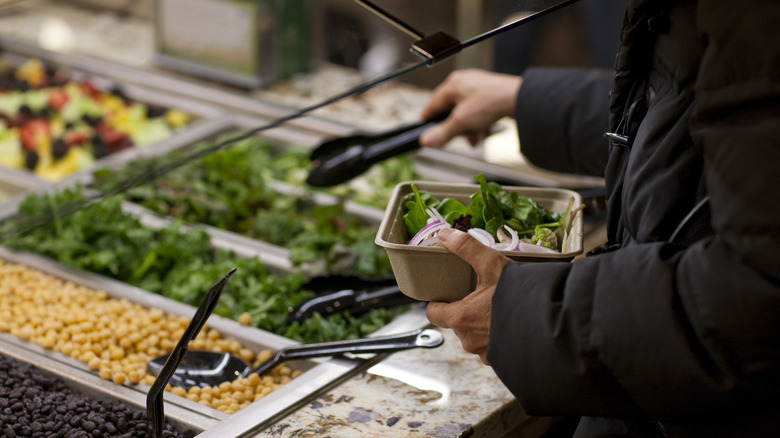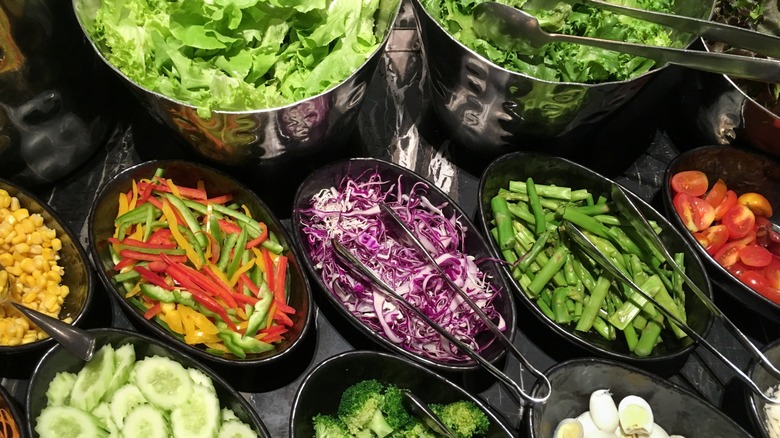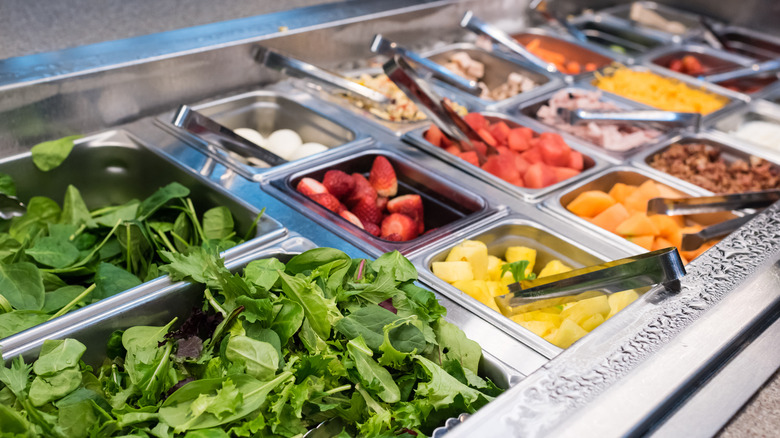Grocery Stores Often Use Old Produce For The Salad Bar. Should You Care?
When shopping at your local grocery store, it's hard to miss the colorful cornucopia of fresh fruits and veggies that fill the salad bar. For the bold, it's an adventure of discovery, and for those who are choosey about what they eat, the bar offers a form of security, knowing that only what you find appealing will end up on your plate. But how old are the vibrant ingredients that fill the tubs? In some cases, they are older than you might think.
Some items in grocery stores approaching their "best by" date are commonly repurposed for salad and hot bars in-store. Lettuce that is beginning to wilt can be given new life with a few quick passes of a knife, and cucumbers that are approaching the end of their shelf life look fresh and appealing after a little chopping. But before you chide the local market, remember that you (very sensibly) do the same thing at home.
Maybe you brought a tomato home and found the journey from the store to your kitchen counter bruised it in one spot. That tomato doesn't get thrown away; the bruised part gets cut off and removed, and you use the rest of it to make a tasty dish. The salad bar at the grocery store does the same thing on a larger scale. That older produce is just as safe to consume as when it was in its whole form, partly because the grocery stores managing the salad counters follow strict food safety guidelines.
How old is it, and is it safe?
Produce prepped in the salad counter likely hasn't been there long, but its overall age depends on what it is. Leafy greens probably haven't been in the store for much longer than a week, whether displayed at the salad bar or in the produce section. However, other produce, like apples, — normally harvested in the fall — are usually ten months old if you're buying them in the middle of summer. They're kept fresh for months by being put into controlled storage immediately after harvesting, and they're put out for sale when there is a demand. Apple slices available at a salad bar may be aged, but only slightly more so than their counterparts in the produce section.
Once old produce gets repurposed for a salad bar, it's considered a food that needs time and temperature control for safety — a TCS food. The FDA suggests TCS foods be discarded a week after being cut, and leafy greens fall into this category. Those products are labeled with expiration dates unless they will be out for less than 24 hours. The produce you see at the grocery store salad bar hasn't been there long and often won't be there for more than a day. There's no reason to be wary of the old produce you see on the salad counter in the grocery store, and if you're clever, you can make some of the items there work to your financial advantage.
Use salad bars to your advantage
Along with older produce, many salad bars in grocery stores offer toppings for your greens like walnuts, bacon bits, and various types of cheese. Most salad bars charge by the weight of your container and some of the items displayed cost less when purchased that way. If you're planning on making a dish that requires cooking and crumbling bacon, it may be worth dropping by your local grocery store and purchasing a half cup of bacon bits from the salad bar. Depending on what the store charges per pound, you might get the bacon at a significant discount compared to buying it in the refrigerated section, and you won't have to worry about washing any greasy pans afterward. When you need just a few walnuts for a loaf of banana bread, the salad counter in the grocery store may be your cheapest and most convenient option to acquire a limited amount.
The fact that grocery stores utilize old produce by putting it on a salad bar isn't something to be concerned about from a safety standpoint. It's really a testament to the establishment's commitment to minimizing food waste while providing its customers with a veggie-packed lunch option. The next time you see the salad counter at the grocery store, know that it is almost certainly housing old produce — and that's fine because it's still a perfectly safe, convenient way to get a quick lunch for a reasonable price.


